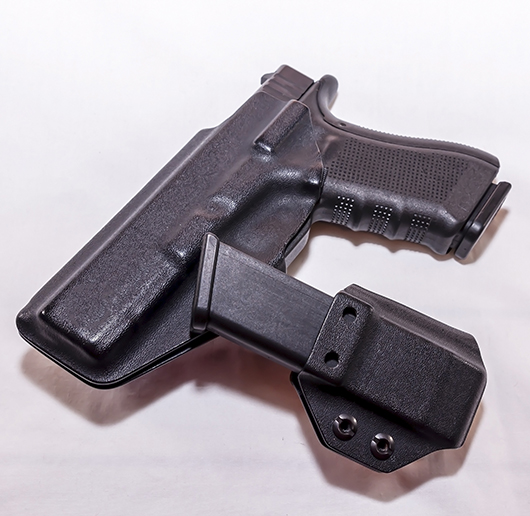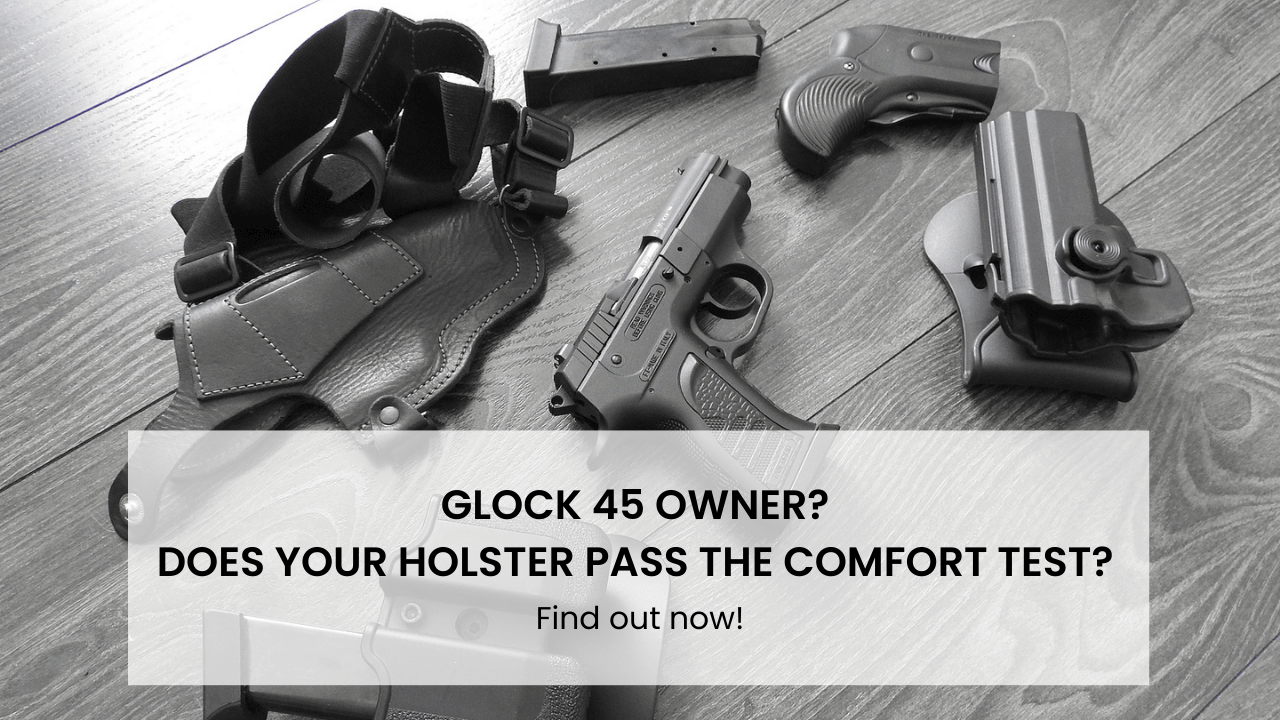Essential Features of a Safe Concealed Carry Holster
Jan 11th 2021

Carrying a firearm for self-defense is a tremendous responsibility. You’re not only carrying a gun to save your own life — you’re carrying a deadly weapon that must be mastered. Part of that responsibility is carrying your weapon safely. Holster design plays a role, and so does your chosen carry position.
Holster Elements
The design of a holster should provide the following:
- Retention: The first function of a holster must be to keep the weapon securely in place. Regardless of whether you’re sitting, standing, or jogging, the gun should remain in its holster. Your pistol is no good to you if it falls out as you dash to your car or run down the street to catch a bus. It’s also critical that the firearm is not easy to take from you.
- Safety: The trigger guard should be covered so that when you place your hand on the weapon, your index finger must remain straight against the side of the holster and the pistol as it’s drawn. If a holster requires that you place you curl your index finger — e.g., to depress a button — or doesn’t cover the trigger guard entirely, it increases your risk of experiencing an unintentional discharge.
- Rigidity: Related to safety, the holster should not be easily collapsible, especially when the weapon is drawn. If you have to open the holster mouth with your support hand to re-holster your gun, you risk muzzle-sweeping yourself. If the holster is made from leather or soft cloth-like material, there’s a risk that this material will deform. The substance may enter the trigger guard when you re-holstering and causing an unintentional discharge. This is especially dangerous regarding appendix carry.
- Accessibility: As your sidearm is a defensive weapon for you to call upon in an emergency, you must be able to apply a full firing grip on the gun as you draw it from the holster. For concealed carry, your access may be interfered with by complicated retention devices.
Materials
Companies that manufacture gun holsters almost always use one of three materials:
- Leather: Still a highly popular choice, leather is tanned animal hide, usually steer or cowhide. Leather holsters are often prized for their ornate needlework and pliability. The material can conform to the body over time, becoming increasingly more comfortable. Unfortunately, leather is also susceptible to deforming or absorbing moisture.
- Nylon: A heavy-duty fabric, nylon holsters usually rely on a flap or snap closure for retention. While nylon holsters can be effective for retention, this can be at the expense of accessibility.
- Kydex: Kydex is a durable thermoplastic thermoformed to the firearm’s exterior dimensions, allowing for a custom fit. Kydex holsters are resistant to chemicals, such as cleaning solvents and lubricating oils, water, and abrasion.
Waistband Holsters
A holster worn on the belt is the traditional method of carrying a firearm, whether openly or concealed. Regardless of where you position the holster on your belt, belt holsters fall into two broad categories:
- IWB: Inside the waistband, an IWB holster is the best kind of belt holster for deep concealment, as the muzzle of the gun and part of the holster are concealed below the beltline by the trousers. The primary disadvantage of IWB is that it often requires that you wear a larger waist size and can be uncomfortable with full-size handguns.
- OWB: Outside the waistband, OWB holsters provide less concealment but are an excellent choice for carrying full-size service pistols. OWB is also suitable for open carry.
Whether IWB or OWB, belt holsters can accommodate several carry positions:
- Strong side: Your strong side is your dominant side. If you’re right-handed, your strong side is your right hip. Holstering your gun by your right hip is by far the most common carry position and one of the fastest.
It also allows you to use your support hand to defend yourself while you draw, keeping the threat as far away from your weapon as possible. However, drawing your gun while seated in a vehicle can be difficult. - Appendix: An increasingly popular carry position, this places the weapon at 12 or 1 o’clock. One of the easiest to conceal holsters, particularly with a loose-fitting T-shirt or collared shirt is the appendix carry. This method of carry is also one of the fastest to draw from. However, it’s controversial because of the direction in which the muzzle is pointed. As a result, you must exercise caution and practice safely.
- Small of back: Like appendix carry, the small of the back offers enhanced concealment due to the way clothing fabric drapes over the back. However, some worry that having your pistol pressed against your spine may be a problem should you fall.
- Crossdraw: Located on the support side, this type of holster positions the pistol butt forward to be gripped with the dominant hand. Reaching across to draw the pistol can be more comfortable for some, especially those with shoulder injuries, who can’t draw from a strong-side position.
Non-Belt Holsters
Gun holsters that don’t require a belt comprise several designs and configurations. One is the waistband holster. This category includes belly bands and corset holsters.
- Belly band: A belly band is a wide belt-like elastic band that wraps around the waist and allows you to carry a firearm without requiring that you wear pants or a traditional gun belt. If you prefer to wear dresses, skirts, or other free-flowing garments that don’t provide for a strong-side holster, this may be the perfect option.
- Corset: The corset holster bears some resemblance to the belly band insofar as it wraps around the waist. However, the key difference is that the corset type closes in the front and typically contains storage pockets for the gun and spare ammunition. Heavily marketed toward women, several corset holsters close using brassiere fasteners.
Belly bands, in contrast, are unisex.
Shoulder Holsters

The second type of non-belt option is the shoulder holster. While traditionally associated with action heroes and police detectives, the shoulder holster is a viable option for those who spend most of their day sitting or driving. Pregnant women who cannot wear a gun belt may also consider the shoulder holster a good alternative.
Shoulder holsters do restrict your wardrobe, as you’ll need to wear a jacket to conceal it. Even then, the harness may be visible or identifiable by touch, so bear that in mind. Many shoulder holsters come equipped with single or dual magazine pouches located on the opposite side, retrievable by your support hand.
Regarding safety, shoulder holsters also cant the muzzle in two different directions depending on design — vertically toward the ground and horizontally. Even if you’re wearing a vertical shoulder holster, you still risk flagging bystanders with the muzzle every time you bend over.
Ankle Holsters
For a backup weapon, such as a snub-nosed revolver or subcompact semi-automatic pistol, the ankle holster is a popular choice. It’s beneficial if, as with the shoulder holster, you are sedentary. For an ankle holster to be viable, your pants must provide sufficient space and length to cover the weapon.
Thigh Holsters
For men who prefer sportswear or women who choose to wear dresses, skirts, or other free-flowing clothing, a thigh holster can take the form of an elastic band that holds the pistol snugly against your leg. This is opposed to the tactical law enforcement rigs we’re used to seeing on the news.
Pocket Carry
For lightweight subcompact or backup handguns, carrying the pistol in a holster inside a pants pocket is an alternative option to the ankle holster. Still less accessible than a strong-side or appendix belt holster, it allows greater access than the ankle.
In Conclusion
Finding the right holster can be a challenging affair, regardless of whether you’re new to firearms or experienced. At Incognito Concealment, we know that there are many factors that you have to consider when choosing a gun holster. Among these is safety. Call us at (586) 333-4240, and we can help you find a holster that suits your needs.











